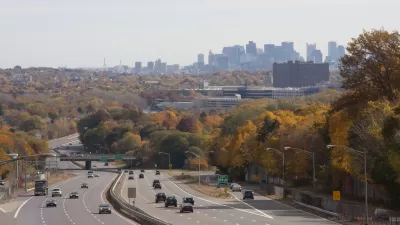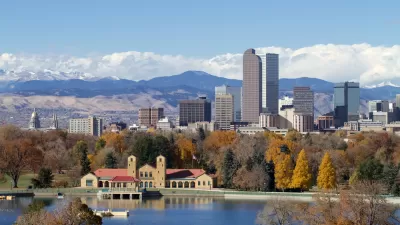Research from BuildZoom, a San Francisco-based contractors' website, shows that housing affordability increases with a region's ability to build outwards, as opposed to upwards. Densification largely has not accompanied efforts to curb sprawl.

Sprawl may be bad for the environment and livability, increasing dependence on the automobile and making transit less practical, but in terms of housing affordability, it's a winner, according to research released Sept. 14 by Issi Romem, chief economist at BuildZoom and author of the study.
"Environmentalists, urban planners and economists are pushing cities such as New York and San Francisco to build more housing to help combat rapidly rising rents and home prices that are crowding out the middle class," reports Laura Kusisto who covers housing and the economy for The Wall Street Journal. [No paywall on this article]. "But trying to build upward in order to keep cities accessible to average families may be a losing battle," according to the research.
Even cities that were able to increase the pace of housing construction without sprawling, such as Portland and Seattle, were unable to keep pace with demand nearly as well as their counterparts that spread outward. Portland saw inflation-adjusted home values increase 78% from 1980 to 2010 and Seattle saw home prices jump 119%, according to BuildZoom. Meanwhile, Las Vegas saw real home values increase just 4.7% and Atlanta saw a mere 14% jump.
Of course, Portland and Seattle may not wish to look like Las Vegas or Atlanta.
If American cities were willing to level single-family homes and build apartment towers, they could likely keep up with demand without sprawl, but that is unlikely given the political power given to local community groups and the radical changes that would mean to virtually any American city outside of Manhattan.
But what about vacant urban land?
A 14-acre highrise development in Chicago broke ground on September 12 without leveling any homes, or apparently anything, for that matter. The site of the Riverline development along the Chicago River "is currently little more than vacant land straddling Bertrand Goldberg’s 1986 River City," reports Jay Koziarz for Curbed Chicago. It will include a 29-story tower containing 420 rental units, an 18-story, 251-unit tower "and a series of nine three-story townhouses."
However, vacant land is more likely the exception than the rule in thriving cities. Local resistance to dense development, particularly to high-rises, may be the norm.
Unless cities "enact fundamental changes that allow for substantially more densification, cities confronting growth pressure face a tradeoff between accommodating growth through outward expansion, or accepting the social implications of failing to build enough new housing," notes Romem in one of four 'key takeaways' that appear at the top of his study.
"The big takeaway is that if expensive cities like New York and San Francisco want to do something about affordability they have to do so at a scale that is unprecedented in this country," Romem told Kusisto. "Realistically the odds of that happening are slim to none."
And the statistics prove it.
Indeed, housing production in the U.S. remains overwhelmingly concentrated in suburban, not urban areas. More than 88% of new homes in the 2000s were built in undeveloped or suburban areas, according to BuildZoom.
The findings ultimately seem to offer two unappealing scenarios: a future in which cities continue to eat into the neighboring countryside and commute times and pollution rises, or one in which home prices in some cities will become out of reach for more people.
Related:
- BuildZoom Research: Can U.S. Cities Compensate for Curbing Sprawl by Growing Denser? September 14, 2016, by
More on Planetizen:
- Urban Growth Boundaries Gone Awry: Protection Without Infill, September 7, 2016
- Does America Still Want Sprawl?, March 2, 2015
Hat tip to Loren Spiekerman
FULL STORY: What If Urban Sprawl Is the Only Realistic Way to Create Affordable Cities?

Study: Maui’s Plan to Convert Vacation Rentals to Long-Term Housing Could Cause Nearly $1 Billion Economic Loss
The plan would reduce visitor accommodation by 25,% resulting in 1,900 jobs lost.

Alabama: Trump Terminates Settlements for Black Communities Harmed By Raw Sewage
Trump deemed the landmark civil rights agreement “illegal DEI and environmental justice policy.”

North Texas Transit Leaders Tout Benefits of TOD for Growing Region
At a summit focused on transit-oriented development, policymakers discussed how North Texas’ expanded light rail system can serve as a tool for economic growth.

San Diego County Sees a Rise in Urban Coyotes
San Diego County experiences a rise in urban coyotes, as sightings become prevalent throughout its urban neighbourhoods and surrounding areas.

Los Angeles County Invests in Wildfire Recovery for Parks, Trails, and Open Space
The $4.25 million RESTORE Program supports the recovery of parks, trails, and open spaces damaged by the January 2025 wildfires through targeted grants that promote community healing, wildfire resilience, and equitable access to nature.

Nevada Bills Aim to Establish Home Insurance Assurance Amidst Wildfire Risk
Republican sponsor hopes the FAIR plan would be “a true market of last resort.”
Urban Design for Planners 1: Software Tools
This six-course series explores essential urban design concepts using open source software and equips planners with the tools they need to participate fully in the urban design process.
Planning for Universal Design
Learn the tools for implementing Universal Design in planning regulations.
Smith Gee Studio
Alamo Area Metropolitan Planning Organization
City of Santa Clarita
Institute for Housing and Urban Development Studies (IHS)
City of Grandview
Harvard GSD Executive Education
Toledo-Lucas County Plan Commissions
Salt Lake City
NYU Wagner Graduate School of Public Service



























